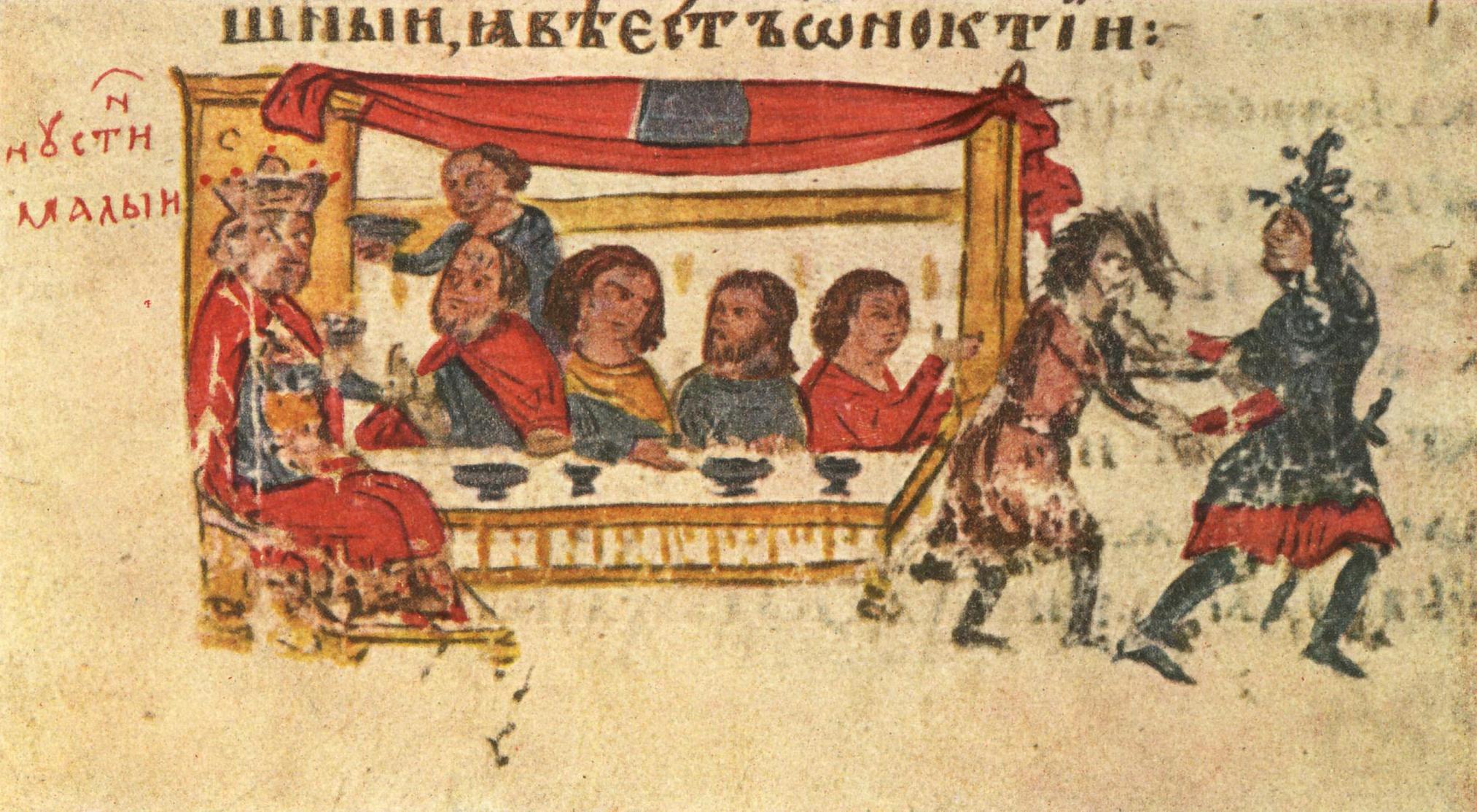|
Anastasius Of Samaria
Anastasius ( el, Αναστάσιος) was a Byzantine official, active in the reign of Justin II (r. 565–578). He held the positions of magister officiorum and quaestor sacri palatii. He seems to have died by the mid-570s.Martindale, Jones & Morris (1992), p. 64–66 Anastasius was a native of Samaria, as recorded by John of Ephesus. The same primary source calls Anastasius both a Samaritan and a Palestinian, presumably as geographic terms. He is first mentioned as the subject of a panegyric composed by Flavius Cresconius Corippus. The poem is dated to late 565 or early 566. It describes Anastasius as holding the offices of magister officiorum and quaestor sacri palatii. This indicates that Anastasius had been appointed by Justin II, soon after the latter rose to the throne (14–15 November 565). He was presumably a loyal supporter or political ally of Justin. He probably succeeded Constantine as quaestor and Peter the Patrician as magister. Both men were long-serving ... [...More Info...] [...Related Items...] OR: [Wikipedia] [Google] [Baidu] |
Justin II
Justin II ( la, Iustinus; grc-gre, Ἰουστῖνος, Ioustînos; died 5 October 578) or Justin the Younger ( la, Iustinus minor) was Eastern Roman Emperor from 565 until 578. He was the nephew of Justinian I and the husband of Sophia, the niece of the Empress Theodora, and was therefore a member of the Justinian dynasty. Justin II inherited a greatly enlarged but overextended empire, with far less resources at his disposal compared to Justinian I. Despite this, he strived to match his formidable uncle's reputation by abandoning the payment of tributes to the Empire's neighbors. This miscalculated move resulted in rekindling of war with the Sassanid Empire, and in a Lombard invasion which cost the Romans much of their territory in Italy. Family He was a son of Vigilantia and Dulcidio (sometimes rendered as Dulcissimus), respectively the sister and brother-in-law of Justinian. His siblings included Marcellus and Praejecta. With Sophia he had a daughter Arabia and possibly ... [...More Info...] [...Related Items...] OR: [Wikipedia] [Google] [Baidu] |
Constantinople
la, Constantinopolis ota, قسطنطينيه , alternate_name = Byzantion (earlier Greek name), Nova Roma ("New Rome"), Miklagard/Miklagarth (Old Norse), Tsargrad ( Slavic), Qustantiniya (Arabic), Basileuousa ("Queen of Cities"), Megalopolis ("the Great City"), Πόλις ("the City"), Kostantiniyye or Konstantinopolis ( Turkish) , image = Byzantine Constantinople-en.png , alt = , caption = Map of Constantinople in the Byzantine period, corresponding to the modern-day Fatih district of Istanbul , map_type = Istanbul#Turkey Marmara#Turkey , map_alt = A map of Byzantine Istanbul. , map_size = 275 , map_caption = Constantinople was founded on the former site of the Greek colony of Byzantion, which today is known as Istanbul in Turkey. , coordinates = , location = Fatih, İstanbul, Turkey , region = Marmara Region , type = Imperial city , part_of = , length = , width ... [...More Info...] [...Related Items...] OR: [Wikipedia] [Google] [Baidu] |
Medieval Samaritan People
In the history of Europe, the Middle Ages or medieval period lasted approximately from the late 5th to the late 15th centuries, similar to the post-classical period of global history. It began with the fall of the Western Roman Empire and transitioned into the Renaissance and the Age of Discovery. The Middle Ages is the middle period of the three traditional divisions of Western history: classical antiquity, the medieval period, and the modern period. The medieval period is itself subdivided into the Early, High, and Late Middle Ages. Population decline, counterurbanisation, the collapse of centralized authority, invasions, and mass migrations of tribes, which had begun in late antiquity, continued into the Early Middle Ages. The large-scale movements of the Migration Period, including various Germanic peoples, formed new kingdoms in what remained of the Western Roman Empire. In the 7th century, North Africa and the Middle East—most recently part of the Eastern Roman ... [...More Info...] [...Related Items...] OR: [Wikipedia] [Google] [Baidu] |
6th-century Byzantine People
The 6th century is the period from 501 through 600 in line with the Julian calendar. In the West, the century marks the end of Classical Antiquity and the beginning of the Middle Ages. The collapse of the Western Roman Empire late in the previous century left Europe fractured into many small Germanic kingdoms competing fiercely for land and wealth. From the upheaval the Franks rose to prominence and carved out a sizeable domain covering much of modern France and Germany. Meanwhile, the surviving Eastern Roman Empire began to expand under Emperor Justinian, who recaptured North Africa from the Vandals and attempted fully to recover Italy as well, in the hope of reinstating Roman control over the lands once ruled by the Western Roman Empire. In its second Golden Age, the Sassanid Empire reached the peak of its power under Khosrau I in the 6th century.Roberts, J: "History of the World.". Penguin, 1994. The classical Gupta Empire of Northern India, largely overrun by the Huna, ended ... [...More Info...] [...Related Items...] OR: [Wikipedia] [Google] [Baidu] |
570s Deaths , a semi-automatic pistol
{{Numberdis ...
57 may refer to: * 57 (number) * one of the years 57 BC, AD 57, 1957, 2057 * "57" (song), a song by Biffy Clyro * "Fifty Seven", a song by Karma to Burn from the album ''Arch Stanton'', 2014 * "57" (album), a studio album by Klaus Major Heuser Band in 2014 * "57 Live" (album), a live double-album by Klaus Major Heuser Band in 2015 * Heinz 57 (varieties), a former advertising slogan * Maybach 57, a car * American Base Hospital No. 57 * Swift Current 57's, baseball team in the Western Canadian Baseball League * FN Five-Seven The FN Five-seven (stylized as Five-seveN) is a semi-automatic pistol designed and manufactured by FN Herstal in Belgium. The pistol is named for its 5.7×28mm (.224 in) bullet diameter, and the trademark capitalization style is intended to ... [...More Info...] [...Related Items...] OR: [Wikipedia] [Google] [Baidu] |
Good Friday
Good Friday is a Christian holiday commemorating the crucifixion of Jesus and his death at Calvary. It is observed during Holy Week as part of the Paschal Triduum. It is also known as Holy Friday, Great Friday, Great and Holy Friday (also Holy and Great Friday), and Black Friday. Members of many Christian denominations, including the Catholic, Eastern Orthodox, Lutheran, Anglican, Methodist, Oriental Orthodox, United Protestant and some Reformed traditions (including certain Continental Reformed, Presbyterian and Congregationalist churches), observe Good Friday with fasting and church services. In many Catholic, Lutheran, Anglican and Methodist churches, the Service of the Great Three Hours' Agony is held from noon until 3 pm, the time duration that the Bible records as darkness covering the land to Jesus' sacrificial death on the cross. Communicants of the Moravian Church have a Good Friday tradition of cleaning gravestones in Moravian cemeteries. The date of Good Fr ... [...More Info...] [...Related Items...] OR: [Wikipedia] [Google] [Baidu] |
True Cross
The True Cross is the cross upon which Jesus was said to have been crucified, particularly as an object of religious veneration. There are no early accounts that the apostles or early Christians preserved the physical cross themselves, although protective use of the sign of the cross was common by at least the 2nd century. Post-Nicene historians such as Socrates of Constantinople relate that Helena, the mother of the Roman emperor ConstantineI, travelled to the Holy Land in the years 326–328, founding churches and establishing relief agencies for the poor. The late 4th-century historians Gelasius of Caesarea and Tyrannius Rufinus claimed that while there she discovered the hiding place of three crosses that were believed to have been used at the crucifixion of Jesus and the two thieves, St. Dismas and Gestas, executed with him. To one cross was affixed the titulus bearing Jesus's name, but according to Rufinus, Helena was not sure until a miracle revealed that this was t ... [...More Info...] [...Related Items...] OR: [Wikipedia] [Google] [Baidu] |
Non-epileptic Seizure
Non-epileptic seizures (NES), also known as non-epileptic events, are paroxysmal events that appear similar to an epileptic seizure but do not involve abnormal, rhythmic discharges of neurons in the brain. Symptoms may include shaking, loss of consciousness, and loss of bladder control. They may or may not be caused by either physiological or psychological conditions. Physiological causes include fainting, sleep disorders, and heart arrhythmias. Psychological causes are known as psychogenic non-epileptic seizures. Diagnosis may be based on the history of the event and physical examination with support from heart testing and an EEG. Terminology The International League Against Epilepsy (ILAE) define an epileptic seizure as "a transient occurrence of signs and/or symptoms due to abnormal excessive or synchronous neuronal activity in the brain." (Free full text online). Convulsive or non-convulsive seizures can occur in someone who does not have epilepsy – as a consequence of h ... [...More Info...] [...Related Items...] OR: [Wikipedia] [Google] [Baidu] |
Samaritanism
Samaritanism is the Abrahamic, monotheistic, ethnic religion of the Samaritan people, an ethnoreligious group who, alongside Jews, originate from the ancient Israelites. Its central holy text is the Samaritan Pentateuch, which Samaritans believe is the original, unchanged version of the Torah. Samaritans describe their religion as the holy faith that began with Moses, unchanged over the millennia that have since passed. Samaritans believe that the Jewish Torah, and Judaism, have been corrupted by time and no longer serve the duties that God mandated to the Israelites on Mount Sinai. The holiest site for Samaritans in their faith is Mount Gerizim near Nablus, while Jews view the Temple Mount in Jerusalem as their most sacred location. History Samaritanism holds that the summit of Mount Gerizim is the true location of God's Holy Place. Samaritans trace their history as a separate entity to a period soon after the Israelites' entry into the Promised Land. Samaritan histori ... [...More Info...] [...Related Items...] OR: [Wikipedia] [Google] [Baidu] |
Crypto-Paganism
Crypto-paganism is the secret adherence to paganism while publicly professing to be of another faith. In historical context, a crypto-pagan (from the Greek ''kryptos'' – , "hidden") was most likely to maintain the pretense of believing an Abrahamic religion, while continuing to observe their own religious practices in private. Hiding one's true religious faith may be in response to a perceived danger of rejection by society, or else to formalized persecution by an established government or religious organization. In antiquity and the early Byzantine Empire Anthemius, one of the last Roman emperors of the West who ruled from 467 to 472, surrounded himself with prominent pagans such as Messius Phoebus Severus and was believed to hold pagan views. According to Damascius, Severus and Anthemius had a secret plan to restore the Pagan cults. The murder of Anthemius (by Ricimer) destroyed the hopes of those pagans who believed that the traditional rites would be restored. Anatolius (O ... [...More Info...] [...Related Items...] OR: [Wikipedia] [Google] [Baidu] |
List Of Ecumenical Patriarchs Of Constantinople
This is a list of the Patriarchs of Constantinople. Bishops of Byzantium (until 330) *1. St. Andrew the Apostle (38), founder *2. St. Stachys the Apostle (38–54) *3. St. Onesimus (54–68) *4. Polycarpus I (69–89) *5. Plutarch (89–105) *6. Sedecion (105–114) *7. Diogenes (114–129) *8. Eleutherius (129–136) *9. Felix (136–141) *10. Polycarpus II (141–144) *11. Athenodorus (144–148) *12. Euzois (148–154) *13. Laurence (154–166) *14. Alypius (166–169) *15. Pertinax (169–187) *16. Olympianus (187–198) *17. Mark I or Marcus I (198–211) *18. Philadelphus (211–217) *19. Cyriacus I (217–230) *20. St. Castinus (230–237) *21. Eugenius I (237–242) *22. Titus (242–272) *23. Dometius (272–284) *24. Rufinus I (284–293) *25. Probus (293–306) *26. St. Metrophanes (306–314) *27. St. Alexander (314–337) Archbishops of Constantinople (330–451) *28. St. Paul I ("the Confessor") (337–339) *29. Eusebius of Nicomedia (339–3 ... [...More Info...] [...Related Items...] OR: [Wikipedia] [Google] [Baidu] |







